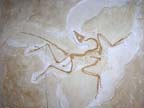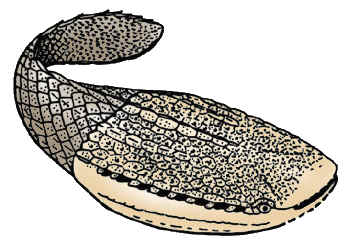 |
 |
 |
 |
 |
Produced
by the Population Genetics and Evolution class, Furman University |
||||
 |
 |
 |
 |
 |
Produced
by the Population Genetics and Evolution class, Furman University |
||||
 |
The
Ordovician: Ostracoderms |
 |
||
| 'Ostracoderm'
is a term applied to a very diverse, paraphyletic group of primitive,
jawless fishes (Encyclopedia Britannica 2010) that gave rise to the heterostracans,
galeaspids, and osteostracans (Janvier 1997). They are of particular evolutionary
importance because they represent the earliest major radiation of true
vertebrates (Robertson 1941). Ostracoderms ranged from 3 to 10 inches
long, and were characterized by flat, thick bodies with a pair of side
fins for steering. They had cartilaginous internal skeletons covered by
bony external armor that protected their cephalic and pectoral regions.
Based on these morphological considerations, they most likely lived close
to the sea floor and used their mouths to feed on bottom-dwelling prey.
Most ostracoderms went extinct after the advent of jawed fishes about
400 mya. The only extant relatives of this group are the armorless hagfishes
and lampreys (Indiana Geological Survey 1998). Page by Bob Mazgaj |
 |
| Astraspis: An Example of an Ostracoderm Photo Credit: The Tree of Life Project | |
|
Indiana Geological Survey, Department of Natural Resources. 1998. Ostracoderms: The First Vertebrates. Accessed 8 Feb. 2010. Janvier P. 1997. Vertebrata. Animals with backbones. Tree of Life Project. Padian K. 2010. Ostracoderm.Encyclopedia Britannica. Accessed 8 Feb. 2010. Robertson GM. 1941. The Ostracoderm Order Anaspida, with Description of Some Upper Silurian Material. Transactions of the Kansas Academy of Science 44: 314-317. |